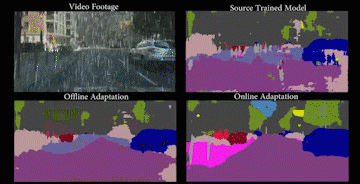Theodoros Panagiotakopoulos1* Pier Luigi Dovesi2 Linus Härenstam-Nielsen3,4* Matteo Poggi5
1 King 2 Univrses 3 Kudan 4 Technical University of Munich 5 University of Bologna
* Part of the work carried out while at Univrses.
📜 Source code for Online Unsupervised Domain Adaptation for Semantic Segmentation in Ever-Changing Conditions, ECCV 2022.
📽️ Check out our project page and video.
OnDA (literally "wave" in Italian) allows for adapting across a flow of domains, while avoiding catastrophic forgetting.
This code has been implemented to perform training and evaluation of UDA approaches in continuous scenarios. The library has been implemented in PyTorch 1.7.1. Some newer versions should work as well.
All assets to run a simple inference can be found here.
Moreover, recording and tracking for the run is happening through wandb if you haven't an account is necessary to track the adaptation.
If you find this repo useful for your work, please cite our paper:
@inproceedings{Panagiotakopoulos_ECCV_2022,
title = {Online Domain Adaptation for Semantic Segmentation in Ever-Changing Conditions},
author = {Panagiotakopoulos, Theodoros and
Dovesi, Pier Luigi and
H{\"a}renstam-Nielsen, Linus and
Poggi, Matteo},
booktitle = {European Conference on Computer Vision (ECCV)},
year = {2022}
}We would advise you to use conda or miniconda to run the package. Run the following command to install the necessary modules:
conda env create -f environment.yml
After creating the environment, load it using conda activate ouda.
You would then need to login to wandb to record the experiments simply type wandb login.
First download the Cityscapes dataset from here. To add rain to the cityscapes dataset you need to follow the steps as shown here. The autors provide the rain mask for each image. With their dev-kit one can create the rainy images.
If you have trouble creating the rainy or foggy dataset, please contact us in [email protected] and we can provide you the dataset.
Download the files precomputed_prototypes.pickle , pretrained_resnet50_miou645.pth and save them into a folder named pretrained
Open the file configs/hybrid_switch.yml and edit the PATH variable with the location of the dataset. The path should point to the leftImg8bit and gtFine folders. Make sure that the paths for the pretrained models at METHOD.ADAPTATION.PROTO_ONLINE_HYBRIDSWITCH.LOAD_PROTO and MODEL.LOAD are correct. The paths should point to the pretrained source and prototypes downloaded in the previous steps.
We recommend using a powerful graphics card with at least 16GB of VRAM. To run this code it needs a bit over 1 day in an RTX3090. If necessary one can play arround with the batch size and resolution on the configuration file to test the approach, but results will not be replicated.
To run first one should initialise wandb wandb login and then simply run python train_ouda.py --cfg=configs/hybrid_switch.yml
The run performs evaluation accross domains from the start and for each pass through the data. We demonstrated how to run the hybrid switch but by configuring or selecting other configuration files one can use different switches or approaches. By default the approach will create folders to save predictions.
The approaches can be found under framework/domain_adaptation/methods:
The code that handles the prototypes can be found in: framework/domain_adaptation/methods/prototype_handler.py
While the switching approach is written here: framework/domain_adaptation/methods/prototypes.py
The Confidence switch (and Soft) is here: framework/domain_adaptation/methods/prototypes_hswitch.py
The Confidence Derivative Switch is here: framework/domain_adaptation/methods/prototypes_vswitch.py
Lastly the code for the hybrid switch can be found here: framework/domain_adaptation/methods/prototypes_hybrid_switch.py
Advent is the implementation here: framework/domain_adaptation/methods/advent_da.py
Don't hesitate to contact us if there are questions about the code or about the different options in the cfg file.
More adaptation? Check our newer work of HAMLET: To Adapt or Not to Adapt? Real-Time Adaptation for Semantic Segmentation.
Thank you!!

